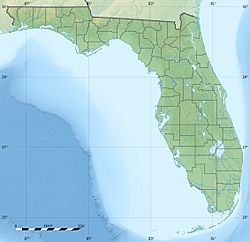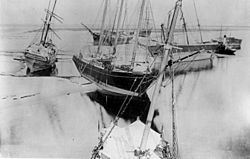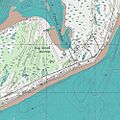Dog Island (Florida) facts for kids
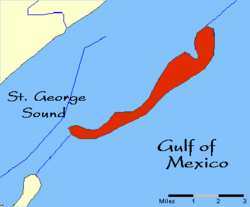
Dog Island, Florida
|
|
| Geography | |
|---|---|
| Coordinates | 29°48′N 84°37′W / 29.80°N 84.61°W |
| Administration | |
| State | |
| County | Franklin |
Dog Island is a small island located off the coast of Carrabelle, in Franklin County, Florida. It's about 3.5 miles (5.6 km) away from the mainland. You can get to Dog Island by ferry on weekends, but you need to make a reservation first.
This island is a quiet place with no stores, restaurants, or public restrooms. It used to have a hotel called the Pelican Inn, but it closed in 2016. Dog Island is less than one mile wide at its widest point and just under seven miles long. Most of the island is a protected wilderness area, owned by The Nature Conservancy. This means it's kept wild to protect nature.
Some parts of the island are important nesting spots for birds. These areas on the east and west ends are off-limits to people and pets to keep the birds safe. Even though it's a wild place, Dog Island has a volunteer fire department, electricity, and trash pickup. The island is also home to a special bird called the Dog Island wren. It's a type of Carolina wren that lives only on Dog Island!
Contents
Dog Island Airport: A Private Airfield
|
Dog Island Airport
|
|||||||||||
|---|---|---|---|---|---|---|---|---|---|---|---|
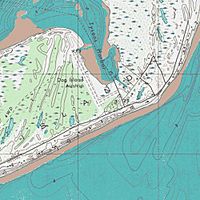
USGS Topographic Map
|
|||||||||||
| Summary | |||||||||||
| Airport type | Private | ||||||||||
| Owner | Dog Island Conservation District | ||||||||||
| Location | Dog Island, Florida | ||||||||||
| Elevation AMSL | 4 ft / 1 m | ||||||||||
| Runway | |||||||||||
|
|||||||||||
|
Source: Federal Aviation Administration
|
|||||||||||
Dog Island has its own small airport, called Dog Island Airport (FA43). It's a private airport, which means it's not open to everyone. It's located near the eastern bay of Dog Island and opened way back in 1930. There isn't a control tower at this airport.
Why Is It Called Dog Island?
The French discovered Dog Island and its two smaller neighbors in 1536. They named it Isle des Chiens, which means "Island of Dogs." There are a few interesting stories about how it got this name:
- Some say there were wild dogs living on the island.
- Others believe the island looks like a dog crouching down.
- A third story suggests that early ships would drop off their common sailors, who were sometimes called "dogs," on the island before docking on the mainland. This was to stop them from running away.
Later, the two neighboring islands were renamed. One is now St. Vincent, which is a federal wildlife refuge. The other is St. George, which has a bridge connecting it to the mainland and has become a popular vacation spot with shops and beach rentals.
After World War II, a Florida businessman named Jeff Lewis saw how special Dog Island was. He bought it for $12,000, thinking it would be a great place for vacations. Long ago, Native Americans used Dog Island as a fishing camp. In 1985, hurricanes uncovered old potsherds (pieces of pottery) on the west end of the island, showing how long people have been visiting.
A Look at Dog Island's Past
Dog Island has a long and interesting history, with signs of people living there over 8,000 years ago. It also has a rich history connected to the sea.
Ancient Mariners and Shipwrecks
In 1999, archaeologists found a 9th-century canoe on the island. This shows that people were exploring these waters in boats a very long time ago! During the 1600s and 1700s, these barrier islands might have been secret hiding spots for pirates and smugglers.
The Shipwreck of Le Tigre
On February 16, 1766, a French merchant ship called Le Tigre was heading to New Orleans. A huge storm hit, and the ship was wrecked about 300 yards (274 meters) east of Dog Island. One survivor, Monsieur Pierre Viaud, wrote a popular book about his experience called The Shipwreck and Adventures of Monsieur Pierre Viaud.
Later, in 1799, the Royal Navy bought a British ship called HMS Fox. Sadly, it also wrecked that same year between Dog Island and St. George Island.
Dog Island in the 1800s
As the United States grew, more ships traveled along the Gulf Coast. Ports like St. Marks, St. Joseph, and Apalachicola became very busy. Ships came to Dog Island to get lumber and other important supplies like turpentine and pitch (a sticky substance from trees). In 1838, the Dog Island Lighthouse was built on the western tip of the island to help guide ships.
During the American Civil War, the Union Navy used Dog Island as a base. From here, they could block ships from entering or leaving Apalachicola.
The Great Hurricane of 1899
On August 1, 1899, a powerful hurricane hit the area. It almost completely destroyed the town of Carrabelle, leaving only nine homes standing. The storm was so strong that a train engine was moved about 100 yards (91 meters) off its tracks!
Many ships were wrecked during this hurricane, some completely destroyed. About 15 ships, many carrying lumber, were lost. These included ships from America, Norway, Russia, and Italy.
Some of the ships believed to have been wrecked were:
- American ships: James A. Garfield, Mary E. Morse, Benjamin C. Cromwell, Grace Andrews, Warren Adams, Vidette, Capitola, Iola, and Albert Haley.
- Norwegian ships: Ranavola, Vale (which archaeologists have found), Elsbeth, Jafnhar, and Hindoo.
- Russian ship: Latara.
- Italian ship: Corteria.
About 40 smaller boats were also sunk or destroyed.
Dog Island in the 1900s
During World War II, Dog Island was part of a large military training area called Camp Gordon Johnston. Soldiers practiced amphibious landings (coming ashore from the sea) and airdrops on the island.
In 1999, a special project called the Dog Island Shipwreck Survey began. Researchers from Florida State University used special equipment like sonar to search the waters around Dog Island for old shipwrecks. They explored the wreck of the Norwegian lumber ship Vale from the 1899 hurricane. They also found other underwater historical sites, including the remains of the old Dog Island Lighthouse.
Dog Island Today
After Hurricane Michael in 2018, parts of two more shipwrecks appeared from under the sand. These are likely more ships that were lost during the big hurricane of 1899.
Images for kids


